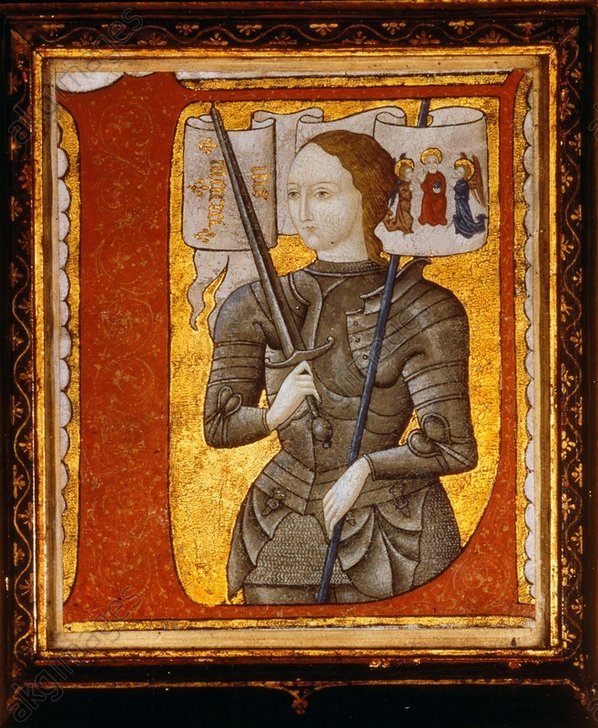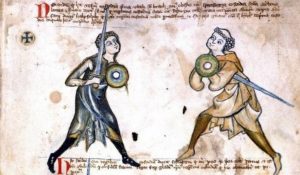Does any one know how much a typical medieval sword really weighed? Less than 4 pounds. Of course, you wouldn’t know this from popular media, where swords are portrayed as nothing more than big, lumbering clubs with edges.
It’s understandable that people have began to picture medieval swords as hefty, crude implements. After all, there are a variety of legends of weapons that only heroes could lift (Excalibur, Mjölnir), plus all sorts of fanciful tales about historical figures who swung blades no normal man could lift. Tales like those cemented the idea of heavy, massive swords in the public consciousness.

But the reality is that a typical medieval sword was the same weight as a carton of soy milk, a Macbook Pro, a young chihuahua, or a bunch of bananas. Even the ginormous “great swords” famous in RPGs like Dungeons & Dragons only weighed between 5-6 pounds, which is considerably less than a gallon of milk.
In other words, medieval swords were lightweights.
This is because swords intended for combat needed to be nimble, balanced, and easy to handle. A heavy sword would have been a liability more than an advantage. A heavy sword would make a wielder slow, ponderous, and add to fatigue, making them easy prey for someone with a faster weapon.
In addition – and contrary to popular opinion – a heavier sword doesn’t hold a significant damage advantage. Instead, the amount of damage a sword causes is mainly a product of the angle, sharpness, and speed when striking. And most swords meant to penetrate armor would do so by thrusting, since if your intention is to bash your opponent with a giant, heavy weapon then you are much better off with a mace or war hammer. But if you want to cut ’em, cut ’em quick.
So why does nerd media portray swords as giant weapons that only a brute could lift? Well, the afore-mentioned legends played a role, but the reality is that massive swords are a power fantasy in genre fiction that have been made popular in video games. Why have a avatar with a nimble weapon that cuts so quick that the graphics barely render, when your character can wield a big, massive weapon that cuts epic swaths through the enemy? I want the big sword, bro.
And this finally brings me to my point. Realism in fantasy literature and media is selective at best. I mean, obviously. Orcs and elves aren’t real, so why are we getting a PhD in medieval sword history here?
I was reading a message thread on a popular website that rhymes with ‘said it’ and a deep-thinking gentleman was adamant that female characters in Skyrim were unrealistic because girls were much too girlie to use a sword. Well, we’ve now established that a sword weighed as much as a 64 ounce squeeze bottle of ketchup, and I’ve never seen a girl who had trouble slinging one of those around.
So what would have kept a woman from wielding a longsword throughout history? Honestly, the only thing that kept more women from using swords is that they rarely got the training. It wasn’t the weight, certainly. And it wasn’t the awkwardness of the swing as swords were designed to be well-balanced and agile.
Nowadays the 2013 longsword champion just happens to be a female (the magnificently named Samantha Swords), yet women in fantasy literature are still too often portrayed in chainmail bikinis. Instead of strong, beautiful women warriors wielding deadly weapons, we most often get clumsy, brainless blade babes. (But, hey, there’s nothing stopping you getting a little martial arts training now.)
But what of the true history of women using swords? Well, let’s close this by rolling the credits, featuring just a few of the countless female warriors, duelists, and military commanders throughout history:
169 CE – Empress Jingu was a member of the the onna-bugeisha, a type of female warrior belonging to the Japanese nobility. She was recognized as the onna-bugeisha who led an invasion of Korea in 200 CE after her husband Emperor Chūai, the fourteenth emperor of Japan, was slain in battle. In 1881, Empress Jingū became the first woman to be featured on a Japanese banknote.
5th Century – Princess Sela was the sister of Koller, King of Norway, and a skilled warrior and pirate. She fought against King Horwendil, and was later killed by him.
529 CE – Princess Halima was princess of the Ghassan Kingdom. In an act of revenge she led a battle against the Lakhmids who had sacrificed her brother to their goddess.
530 CE – Tomyris was the leader of an Iranian nomadic tribe called the Massagetae, who led a successful army that slaughtered the Persians. Tomyris chopped off the head of Cyrus, which she apparently then kept and used as a wine glass.
590 CE – The Christian Synod of Druim Cett ordered that British women should no longer go into battle alongside their men. This ban probably had little effect, and traditions such as sword dancing which was taught by women remained.
623 CE – Princess Zhao Pingyang of China was the daughter of the founding emperor of the Tang Dynasty. Zhao formed a women’s army that she commanded to capture the capital.
624 CE – Hind al-Hunnud was known as the ‘Battle Queen.’ She helped in the battle against Muhammad, mounted upon a camel and leading the armies into battle. Accounts describe her as ‘brandishing a broadsword with great gusto’.
705 CE – Wu Chao, known as ‘The Empress Wu’, is considered to have been one of the most powerful women in history. She is said to have been a forceful, innovative and ruthless leader, with her navy leading a decisive victory at sea, ending China’s long running war with Korea.
705 CE – Apranik was the daughter of a Persian general, and commanded a major battalion against invaders. Her white horse remains a symbol of freedom.
639 CE – Negan was a female guerrilla commander for the Sassanid Empire. Neither born into nobility, nor military trained, Negan fought only out of belief, leading a band of resistance fighters.

7th century – Khawla Bint al-Kindiyyah was a woman warrior, who with the help from her female captains, led an Arab army and stopped a Greek invasion of their homeland. When a Greek soldier knocked Khawlah to the ground, she sliced his head off with a sword, and held it high to inspire her soldiers to victory. When later captured andngered by the confiscation of their weapons, the women led a charge against their Greek captors by using tent poles as weapons and successfully escaped.
783 CE – Fastrada, an East Frankish noblewoman who, along with other Saxon women, entered into battle against Charlemagne’s forces bare breasted. Fastrada then went onto become Charlemagne’s third wife.
918 CE – Ethelfleda, also known as our ‘Lady of the Mercians’, was considered to be a chief military strategist and the most brilliant tactician of her time. She led armies, built castles, united Mercia, and also fought back an invasion from the Vikings, forcing them to surrender their stronghold at York and even conquered Wales, making them to pay tribute to her.
1149 CE – The Order of the Hatchet was a military order of knighthood for women.
1247 CE – Tomoe Gozen was a Japanese samurai warrior known for her bravery and strength. She fought alongside men in the Genpei War.
1409 CE – Han E was orphaned and went to live with her uncle Han Li, proving an excellent scholar in both literature and sword fighting. Disguised as a boy, Han served for over 12 years taking part in military campaigns and was noted for her intelligence, bravery and diligence in her duties. She forbade herself to fraternise with other soldiers in banter or drink in victory celebrations so that nobody would ever guess she was a woman.
1400 CE – Urduja was a legendary warrior princess and heroine in the Philippines. She commanded a army made up of men and women, and she is said to have fought and engaged in duels with other warriors, although many avoided her for the fear of being disgraced by her abilities.
1378 CE – Agnes Hotot Dudley took up arms in place of her ailing father and beat her opponent in a mounted duel. Disguising her sex, she put on a helmet, mounted a horse, and proceeded to the tourney grounds. After what was said to be a ‘stubborn encounter,’ Agnes dismounted her opponent. As he lay on the ground she removed her helmet, let down her hair, and presented her bosom to prove she was a woman and shame her foe. The coat of arms of the House of Dudley shows a woman wearing a military helmet with loosened hair and her breasts exposed, commemorating a female champion.

